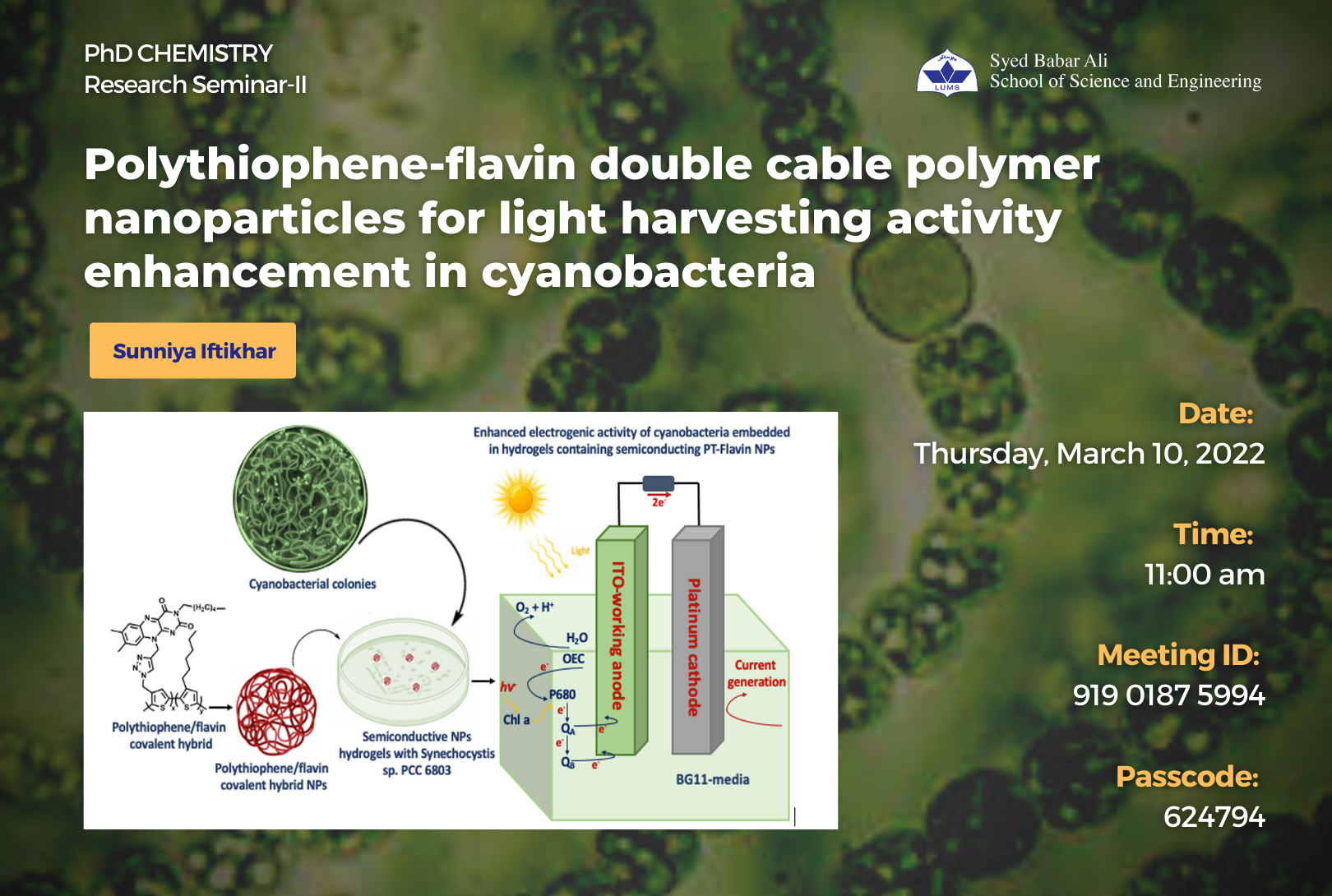
Event date:
Mar
10
2022
11:00 am
Polythiophene-flavin double cable polymer nanoparticles for light harvesting activity enhancement in cyanobacteria
Speaker(s)
Sunniya Iftikhar (2017-13-0013) | PhD Candidate
Venue
ZOOM
Abstract
Owing to their potential for photo-electronic conversion, fine-tuned frontier molecular orbitals and biocompatibility with biological systems, organic semiconducting polymers (OSPs) are extensively explored as light-harvesting systems for diverse biological applications including molecular imaging, artificial photosynthesis, and photo-thermal therapy. By taking the advantage of the effective light harvesting potential of OSPs and the ability of microbial systems to use light energy to drive metabolic cycles for chemical synthesis, the photosynthetic bio-hybrid systems are being considered as one of the emerging and promising directions for solar to fuel production including biophotovoltaics (BPV) for the current generation by solar water splitting, carbon dioxide reduction, hydrogen production, and cofactor generation. Due to the photoactive nature and better biocompatibility, OSPs are being employed to mimic natural photosynthesis via developing photosynthetic bio-hybrid systems in BPV devices. This light-triggered water splitting in the presence of a bio-hybrid catalyst can effectively generate self-sustainable photoelectricity, that provides a captive solution for renewable source energy production. In this seminar, we are presenting a side chain engineered polythiophene copolymer based OSP with pendant azide groups. The target polymer was synthesized by a combination of Grignard Metathesis (GRIM) polymerization and post-synthetic modifications. The pendant azide groups of OSP (electron donor-D) were covalently conjugated to the flavin (non-fullerene acceptor, NFA) moieties via azide-alkyne reaction (i.e., Click reaction) to develop polythiophene-flavin covalent conjugates (PT-Flavin). The OSP with pendant azide groups and its covalent conjugate with flavin were fully characterized using UV/Vis, fluorescence, and 1H-NMR spectroscopies.Fluorescence spectroscopic analysis of the synthesized D-A double cable polythiophene-flavin covalent hybrid and physical hybrid derived from the physical mixing of synthesized OSP and flavin revealed a higher fluorescence quenching in case of the covalent hybrid. Furthermore, azide polymer and polythiophene-flavin covalent hybrid were self-assembled into nanoparticles by using Pluronic F127 surfactant, with size range from 100-150 nm. For proof of concept, we embedded cyanobacteria in a synthetic biofilm containing polythiophene-flavin NPs to improve the light-harvesting ability of cyanobacteria via enhancement of the extracellular electron transfer from cells to electrodes and improved electricity generation in BPV devices. Our novel precisely designed D-A hybrid NPs system when embedded with cyanobacteria based BPV devices triggered a significant enhancement in photocurrent ( 1A) in the devices consisting of photoactive layer derived from the D-A covalent hybrid NPs. This successful integration of biomimetic OSPs derived hybrid systems with photosynthetic microbes offers an exciting avenue for transformation of solar energy to chemical energy (e.g., CO2 capturing, H2 production) as well as bio photoelectricity generation.
Evaluation Committee:
Dr. Basit Yameen (Supervisor)
Dr. Irshad Hussain (Thesis Committee Member)
Dr. Nauman Zafar Butt (Thesis Committee Member)
Dr. Salman Noshear Arshad (Thesis Committee Member)
Meeting ID: 919 0187 5994
Passcode: 624794
Registration link

